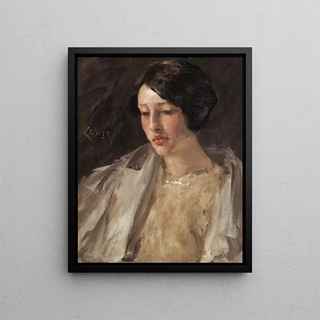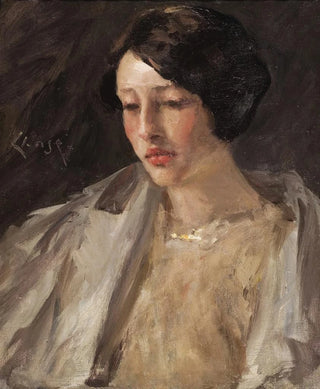Art print | Portrait of Esther M. Groome - William Merritt Chase


View from behind

Frame (optional)
The "Portrait of Esther M. Groome" by William Merritt Chase is an iconic artwork that captures the very essence of feminine beauty at the end of the 19th century. This painting, imbued with delicacy and sophistication, immerses us in a universe where each brushstroke tells a story. The artist, renowned for his skill in capturing light and color, manages to immortalize the grace of his model with rare emotional intensity. Gazing upon this piece, one feels a deep connection with the subject, as if time had stopped to allow Esther M. Groome to share her world with us.
Style and uniqueness of the work
Chase's style is characterized by an impressionist approach that emphasizes light and color, giving his works a vibrant and lively atmosphere. In the "Portrait of Esther M. Groome," he uses warm tones and shadow play to create a depth and dimension that transcend simple representation. The composition is carefully balanced, highlighting Esther's expressive face while incorporating elements of her environment that enrich the visual narrative. The details of the clothing and accessories are treated with remarkable meticulousness, demonstrating the artist's attention to every aspect of his subject. Thus, this work is not limited to a simple portrait; it becomes an open window to an era, a culture, and a personality.
The artist and his influence
William Merritt Chase, a major figure of the American art movement, had a significant influence on his contemporaries and subsequent generations. Born in 1849, he skillfully blended European influences, notably those of French impressionists, with a unique American sensibility. Chase was also a passionate teacher, sharing his knowledge with many students who would go on to become recognized artists in turn. His innovative approach to portraiture, which combines realism and impressionism, paved the way for new explorations in the field of painting. By depicting everyday subjects with such finesse, he helped redefine the very concept of portraiture within American art, making him an essential figure of his time.
An exceptional wall decoration

Matte finish

View from behind

Frame (optional)
The "Portrait of Esther M. Groome" by William Merritt Chase is an iconic artwork that captures the very essence of feminine beauty at the end of the 19th century. This painting, imbued with delicacy and sophistication, immerses us in a universe where each brushstroke tells a story. The artist, renowned for his skill in capturing light and color, manages to immortalize the grace of his model with rare emotional intensity. Gazing upon this piece, one feels a deep connection with the subject, as if time had stopped to allow Esther M. Groome to share her world with us.
Style and uniqueness of the work
Chase's style is characterized by an impressionist approach that emphasizes light and color, giving his works a vibrant and lively atmosphere. In the "Portrait of Esther M. Groome," he uses warm tones and shadow play to create a depth and dimension that transcend simple representation. The composition is carefully balanced, highlighting Esther's expressive face while incorporating elements of her environment that enrich the visual narrative. The details of the clothing and accessories are treated with remarkable meticulousness, demonstrating the artist's attention to every aspect of his subject. Thus, this work is not limited to a simple portrait; it becomes an open window to an era, a culture, and a personality.
The artist and his influence
William Merritt Chase, a major figure of the American art movement, had a significant influence on his contemporaries and subsequent generations. Born in 1849, he skillfully blended European influences, notably those of French impressionists, with a unique American sensibility. Chase was also a passionate teacher, sharing his knowledge with many students who would go on to become recognized artists in turn. His innovative approach to portraiture, which combines realism and impressionism, paved the way for new explorations in the field of painting. By depicting everyday subjects with such finesse, he helped redefine the very concept of portraiture within American art, making him an essential figure of his time.
An exceptional wall decoration






